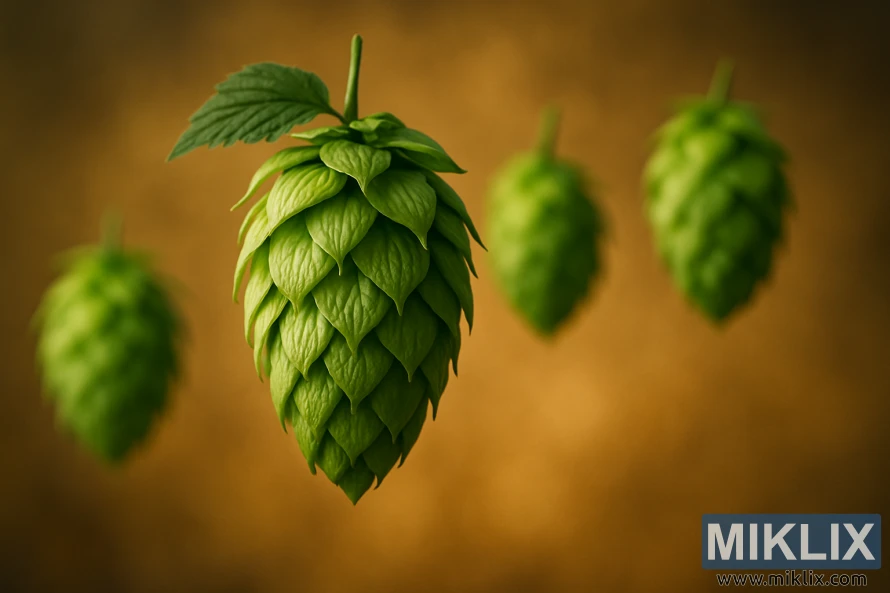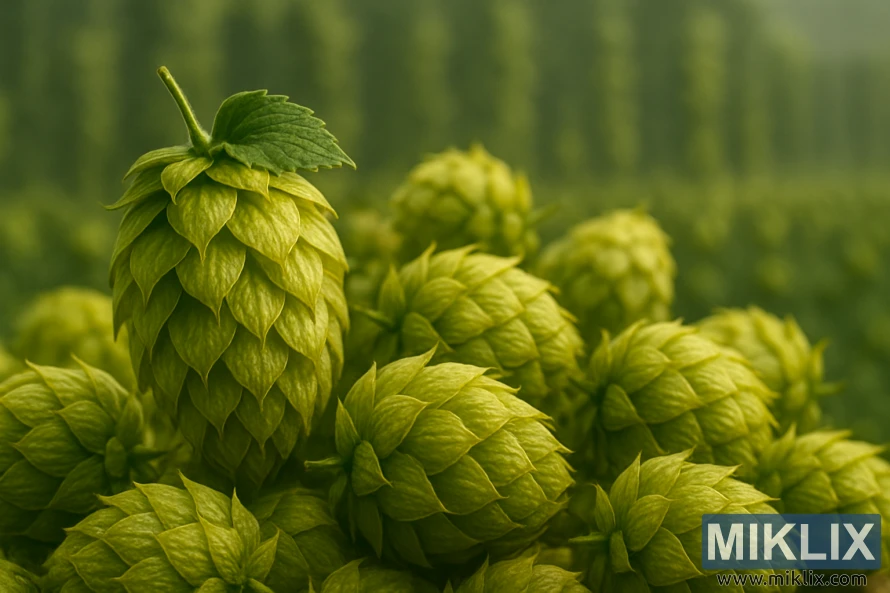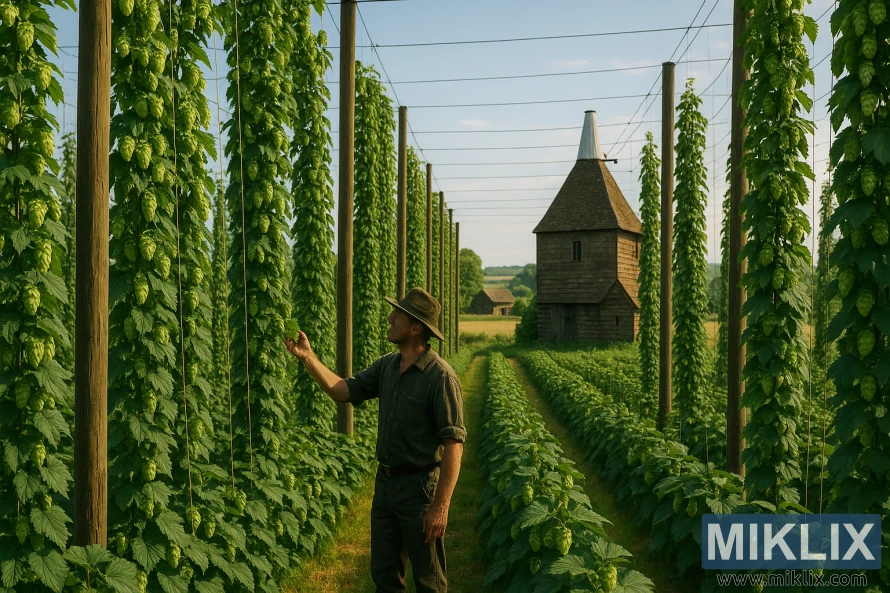Hops in Beer Brewing: Pride of Ringwood
Published: August 18, 2025 at 7:45:50 AM UTC
Beer brewing's rich history is deeply rooted in the use of hops. Albert Steven Nash developed Pride of Ringwood hops as part of a Carlton & United Breweries hop breeding program. These hops have been a cornerstone in Australian brewing for over 70 years. Renowned for their high alpha acid content and distinct flavor, Pride of Ringwood hops are a favorite among brewers. Their unique characteristics make them ideal for a range of beer styles. This includes Australian lagers and pale ales, adding depth and complexity to each brew.

Key Takeaways
- Pride of Ringwood hops are a popular choice among brewers due to their high alpha acid content.
- These hops have been used in Australian brewing for over 70 years.
- Pride of Ringwood hops are suitable for various beer styles, including lagers and pale ales.
- Their distinctive flavor profile adds complexity to beer.
- Pride of Ringwood hops are a staple in Australian brewing.
Introduction to Pride of Ringwood Hops
Pride of Ringwood hops were bred in the 1950s, marking a significant milestone in hop breeding history. Originating in Australia, they were introduced in 1965. Their high alpha acid content and robust disease resistance quickly made them a favorite among brewers.
The breeding program aimed to create a hop that could thrive in Australia's climate. It sought to provide brewers with quality and consistency. The outcome was a hop that exceeded expectations, rapidly gaining popularity in the brewing world.
- High alpha acid content, making them ideal for bittering
- Disease resistance, which reduced crop losses and made them more reliable for farmers
- Adaptability to the Australian climate, paving the way for their widespread cultivation
Pride of Ringwood hops have significantly influenced Australian brewing. They have shaped various beer styles and remain a respected choice among brewers. Their legacy continues to impact the brewing industry, both in Australia and globally.
The Distinctive Characteristics of Pride of Ringwood
Pride of Ringwood stands out in the world of hops. It boasts a balanced yet pronounced flavor and aroma. This Australian hop has been a brewing favorite for decades. Its unique traits add depth and complexity to many beer styles.
The flavor of Pride of Ringwood hops is notable for cedar and oak notes. These are complemented by subtle herbal undertones. This balance makes Pride of Ringwood a go-to ingredient for brewers.
The aroma of Pride of Ringwood is equally distinctive. It enhances the overall sensory experience of beers. The cedar and oak in the aroma perfectly complement the flavor, creating a harmonious balance.
Pride of Ringwood's unique profile makes it suitable for many beer styles. From crisp lagers to hoppy pale ales, it's versatile. Brewers love it for its ability to create a variety of flavors based on brewing techniques and beer style.
- Pride of Ringwood adds a rich, complex flavor profile to beers.
- Its unique aroma characteristics enhance the sensory experience.
- The hop variety is versatile and can be used in various beer styles.

Understanding Pride of Ringwood's Chemical Composition
For brewers aiming to maximize their beer's quality, grasping the chemical makeup of Pride of Ringwood hops is key. These hops are distinguished by their alpha and beta acid content. These components are vital in shaping the beer's bitterness and flavor.
Pride of Ringwood hops boast an alpha acid range of 8.6% to 10.5%. This spectrum positions them for beers needing a balanced bitterness. They are ideal for a wide array of beer styles.
The beta acid content in Pride of Ringwood hops spans from 4.4% to 7.0%. Beta acids are responsible for the hop's flavor and aroma. They can transform into compounds that enrich the beer's complexity.
The blend of alpha and beta acids in Pride of Ringwood hops makes them highly versatile. Here are some critical aspects of their chemical composition:
- Alpha acid content: 8.6-10.5%
- Beta acid content: 4.4-7.0%
- Contributes to bitterness and flavor complexity
- Suitable for various beer styles requiring balanced bitterness and unique flavor profiles
The distinct chemical profile of Pride of Ringwood hops empowers brewers to explore diverse beer styles. From ales to lagers, they can craft beers with the perfect balance of bitterness and flavor.
Growing and Harvesting Methods
Growing Pride of Ringwood hops demands meticulous attention and adherence to best practices. These hops exhibit moderate disease resistance and a growth rate that impacts yield and quality.
Pride of Ringwood hops thrive in well-drained soil with a pH range of 6.0 to 7.0. They need a trellis system to support their tall growth. Farmers blend traditional and modern techniques to enhance hop growth.
The disease resistance of Pride of Ringwood hops is a significant advantage. It minimizes the need for pesticides, promoting sustainable cultivation. Yet, regular disease and pest monitoring is vital for a healthy crop.
Harvesting typically occurs in late summer to early fall, influenced by weather and climate. The process involves cutting the hop cones by machine and drying them to reduce moisture.
Key considerations for growing and harvesting Pride of Ringwood hops include:
- Soil quality and drainage are critical for hop health.
- A trellis system is necessary for their tall growth.
- Regular disease and pest monitoring is essential.
- Harvesting at the optimal time is vital for flavor and aroma.
- Drying hop cones promptly after harvesting is critical for quality preservation.
By adhering to these best practices, farmers and brewers can ensure Pride of Ringwood hops are grown and harvested optimally. This guarantees the best flavor and aroma for beer brewing.

Pride of Ringwood in Commercial Brewing
Australian commercial breweries have long relied on Pride of Ringwood hops. They appreciate the high alpha acid content and distinct flavor profile these hops offer. This is why they're often used in Australian lagers and pale ales, where their unique traits shine.
Pride of Ringwood hops are prized for their balanced bitterness and subtle, earthy flavor. They're perfect for brewers aiming to craft traditional Australian beer styles with a unique character.
The advantages of using Pride of Ringwood hops in commercial brewing are numerous:
- High alpha acid content for effective bittering
- Distinctive earthy and herbal flavor profile
- Compatibility with a range of Australian beer styles, including lagers and pale ales
By integrating Pride of Ringwood hops into their brewing, commercial brewers can produce beers that are both authentic and innovative. The unique qualities of these hops make them essential for creating distinctive Australian beer styles.
Flavor and Aroma Profile Analysis
Pride of Ringwood hops bring a complex flavor and aroma to brewing, enriching the beer's character. Their distinctive taste includes cedar, oak, and subtle herbal notes. These elements create a rich, nuanced brewing experience.
The aroma of Pride of Ringwood hops is deep and earthy, with hints of spice. This complements their robust flavor, making them a top choice for brewers. They seek to add depth and complexity to their beers.
These hops are versatile in brewing, suitable for a range of beer styles. From robust ales to complex lagers, they offer a unique flavor profile. Brewers can achieve a balanced flavor by incorporating Pride of Ringwood hops into their recipes.
Using Pride of Ringwood hops in brewing adds complexity and enhances the beer's aroma. They are a valuable ingredient for craft brewers, elevating the overall brewing experience.

Best Brewing Practices with Pride of Ringwood Hops
Mastering the art of brewing with Pride of Ringwood hops requires a delicate balance. This balance is key to harmonizing their intense flavor with other hop varieties. Brewers must grasp the essential practices for integrating Pride of Ringwood into their recipes effectively.
Pride of Ringwood hops are celebrated for their distinct taste, which can enrich a wide range of beer styles. Yet, their strong character necessitates pairing with other hops to achieve a balanced taste. This approach ensures that the beer's flavor is well-rounded and enjoyable.
- Use Pride of Ringwood hops in moderation to avoid overpowering the other flavors in your beer.
- Combine Pride of Ringwood with other hop varieties, such as bittering hops or aroma hops, to create a balanced flavor profile.
- Consider the alpha acid content of Pride of Ringwood hops when calculating your bittering additions.
- Experiment with different brewing techniques, such as late hopping or dry hopping, to maximize the flavor and aroma of Pride of Ringwood hops.
By adhering to these best practices, brewers can fully harness the essence of Pride of Ringwood hops. This results in complex, well-balanced beers that highlight their unique taste.
Compatible Beer Styles
Pride of Ringwood hops are a top pick for brewing Australian lagers and pale ales. Their high alpha acid content and unique flavor profile are perfect for these beer styles.
In Australian brewing, Pride of Ringwood hops have been a key ingredient for decades. They're essential for lagers and pale ales, adding bitterness, flavor, and aroma. This makes them a favorite among brewers.
The compatibility of Pride of Ringwood hops with various beer styles comes from their:
- High alpha acid content, which provides a robust bitterness
- Distinctive flavor profile, which adds depth to the beer
- Aroma characteristics, which enhance the overall sensory experience
Australian lagers and pale ales brewed with Pride of Ringwood hops showcase the hop's versatility. The crisp, clean taste of lagers and the hoppy flavor of pale ales are both elevated by the unique properties of Pride of Ringwood.
In conclusion, Pride of Ringwood hops are versatile and can be used in a variety of beer styles. They are, though, perfectly suited for Australian lagers and pale ales. Their distinctive characteristics make them a favorite among brewers looking to create traditional Australian beers with a unique twist.

Storage and Preservation Methods
Proper storage of Pride of Ringwood hops is essential for preserving their unique flavor and aroma. These hops can be stored for up to 6 months without a significant loss of quality. This is due to their moderate storage stability.
To maintain the quality of Pride of Ringwood hops, brewers must adhere to best practices for storage. It's important to keep the hops in a cool, dry place, away from sunlight and heat. The ideal storage temperature is below 40°F (4°C).
- Store Pride of Ringwood hops in airtight containers to prevent exposure to air and moisture.
- Keep the containers away from light, as it can cause the hops to degrade.
- Maintain a consistent refrigerated temperature to slow down the degradation process.
By adhering to these storage and preservation methods, brewers can ensure their Pride of Ringwood hops retain their distinctive characteristics. This is vital for achieving the desired flavor and aroma in their beers. Effective hop preservation is key to consistent brewing results.
Common Brewing Challenges and Solutions
Mastering the use of Pride of Ringwood hops in beer brewing demands a thorough grasp of their distinct traits and common obstacles. Brewers who excel in handling and integrating these hops can greatly elevate the caliber of their brews.
One major hurdle brewers encounter with Pride of Ringwood hops is their vulnerability to oxidation. This can result in a diminishment of flavor and aroma, undermining the beer's overall quality. To counteract this, brewers must handle the hops with utmost care, reducing exposure to air and storing them in a cool, dry space.
Here are some common brewing challenges and their solutions when working with Pride of Ringwood hops:
- Oxidation: Store hops in airtight containers and keep them refrigerated or frozen to preserve their properties.
- Inconsistent Flavor Profile: Ensure consistent harvesting and processing methods to maintain the desired flavor and aroma characteristics.
- Difficulty in Achieving Desired Bitterness: Adjust the quantity of hops and the timing of their addition during the brewing process to achieve the desired level of bitterness.
Troubleshooting common issues during brewing requires a systematic approach. Brewers should closely monitor the brewing process, looking out for signs of oxidation, infection, or other problems. By understanding the characteristics of Pride of Ringwood hops and being prepared to address challenges, brewers can craft high-quality beers that highlight the unique qualities of these hops.
Substitutes and Complementary Hops
Pride of Ringwood is a favorite among brewers, but other hops can also enhance its unique taste and smell. Knowing these alternatives is key for brewers looking to try new recipes or avoid supply chain issues.
Pride of Ringwood hops are prized for their high alpha-acid content, perfect for adding bitterness. Brewers often choose Centennial and Galena hops as substitutes for their similar bittering qualities. Centennial, for example, has a balanced alpha-acid content and a floral, citrusy aroma. This makes it a great match or substitute for Pride of Ringwood in many beer styles.
Complementary hops, on the other hand, are used to enhance or change a beer's flavor and aroma. For beers bittered with Pride of Ringwood, hops like Saaz or Hallertau can add unique aromas and flavors. Saaz, with its spicy and earthy notes, can add depth to beers focused on bitterness.
When substituting or complementing Pride of Ringwood hops, consider the specific needs of your brewing application. For bittering, focus on the alpha-acid content. For flavor and aroma, the hop's oil profile and character are more important. Here are some key considerations:
- Alpha-acid content for bittering
- Oil profile for flavor and aroma
- Compatibility with other ingredients in the beer recipe
- Desired flavor and aroma characteristics in the final product
Understanding Pride of Ringwood and its substitutes and complements allows brewers to achieve their desired flavor and aroma. This knowledge enhances recipe flexibility and is invaluable for managing supply chain variability.
Recipe Development Guidelines
The art of recipe development with Pride of Ringwood hops requires understanding its unique attributes. This hop variety can be used in a range of beer styles. It offers brewers the flexibility to experiment with different flavor profiles.
When developing recipes with Pride of Ringwood hops, it's essential to consider its chemical composition. The hop's alpha acid content and unique oil profile contribute to its bitterness and aroma. This makes it a versatile choice for various brewing applications.
To create balanced and complex flavor profiles, brewers can combine Pride of Ringwood hops with other hop varieties. For example, pairing it with citrus-forward hops can add depth to pale ales. Blending it with earthy hops can enhance the character of darker lagers.
- Experiment with different hop combinations to find unique flavor profiles.
- Adjust the quantity of Pride of Ringwood hops based on the desired bitterness and aroma.
- Consider the brewing method and how it affects the hop's flavor and aroma contributions.
By following these guidelines and experimenting with Pride of Ringwood hops, brewers can develop innovative beer recipes. These recipes showcase the hop's unique characteristics.
Conclusion
Mastering Pride of Ringwood hops is a key step in advancing your brewing skills. This hop variety excels in various beer styles, from crisp lagers to hoppy pale ales. Understanding its unique characteristics and optimal brewing practices unlocks its full flavor and aroma.
Optimal results depend on proper storage and preservation methods, along with recipe development. This ensures the unique flavor and aroma of Pride of Ringwood hops are preserved in your beers. As you experiment with Pride of Ringwood hops, you'll discover new flavor combinations, refining your brewing skills.
Pride of Ringwood hops have a rich history and proven performance. Adding them to your brewing repertoire can elevate your beers. This enhances your brewing journey, allowing you to explore new flavors and techniques.
Further Reading
If you enjoyed this post, you may also like these suggestions:
